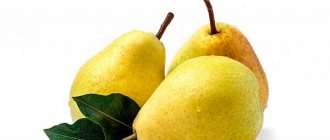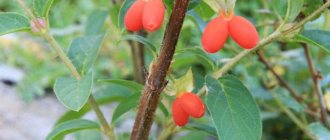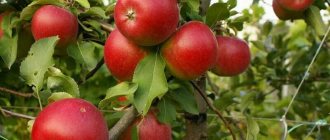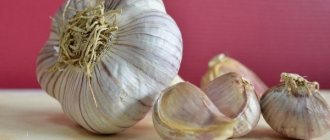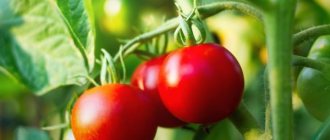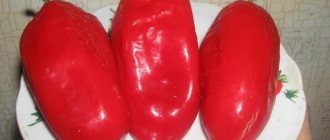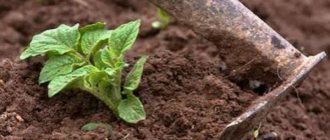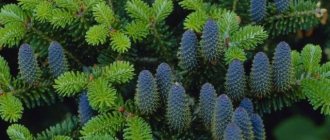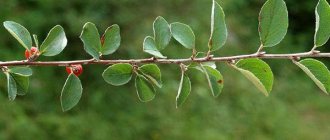When growing pumpkin in summer cottages, they usually give preference to varieties and hybrids with portion-sized fruits: a small pumpkin can be eaten or processed at one time, but large specimens have to be cut, after which they are poorly stored and do not last long. One of these pumpkins with medium-sized and very sweet fruits is the famous variety Kroshka.
The Kroshka pumpkin was bred in the early 2000s at the All-Russian Research Institute of Irrigated Vegetable and Melon Growing, which is located in Astrakhan. Despite the fact that the variety is recommended for cultivation in the Lower Volga region, it can bear fruit well in the Siberian garden.
Pumpkin Kroshka: description and characteristics of the variety
The “Kroshka” variety, despite the name, belongs to the medium-sized table varieties. The plant is relatively compact, so it does not require large areas for cultivation.
“Kroshka” was bred by breeders from the Astrakhan region in the 80s of the last century. The variety was included in the State Register in 1996.
Brief description of the variety:
- Plant. Climbing type. The main stem is powerful and long, reaching a length of 3 m or more. The leaves are lobed, undissected, rich green.
- Fruit. Large, round and slightly flattened. Reach 40 cm in diameter. The rind is thin, grayish in color, and dark green when cut. There are pale pink spots on a gray background. The pulp is moderately juicy, deep orange or yellowish, and occupies most of the fruit.
- Seeds. Oval, yellow, large, with a hard and smooth skin. Can be used for planting.
Pumpkin Seeds Crumb
Pumpkin Baby
Pumpkin tops Crumb reaches three meters
Pumpkin “Kroshka” belongs to the “portioned” varieties. One fruit is ideal for preparing a meal for a small family.
Main characteristics of the “Kroshka” variety:
| Characteristics/parameters | Description/meaning |
| Maturation category | mid-season |
| Full maturity period | 120-130 days |
| Productivity | 3-4 kg per 1 sq. m |
| Storage | Stores well even indoors |
| Fruit weight | 2.5-4 kg |
| Transportability | good |
| Resistance to diseases and pests | high |
| Taste of fruits | sweetish, honey |
| Aroma | melon |
| Purpose | universal – used in cooking and food industry |
100 g of raw pumpkin “Kroshka” contains 9.2% sugars and 12 mg of carotene.
Varieties
Thanks to the work of breeders, many interesting varieties of Honey Pumpkin have appeared.
All of them have a pronounced nutmeg taste, but differ significantly in appearance, shape and characteristics:
- Honey openwork. The pulp is sweet, tasty, and is used for preparing various culinary dishes. One of the varieties suitable for dietary nutrition and complementary feeding of babies. The fruits are round, ribbed, with thick skin, weighing from 3 to 6 kg.
- Honey beauty. The description states that this is the most delicious variety. The pumpkins are round with distinct segments. Average weight is 5 kg. The skin is orange in color with green spots. An early ripening hybrid with fruit ripening in about 90 days.
- Pumpkin of the Honey Orange variety has juicy and sweet pulp, suitable for fresh consumption. The largest fruit weight is 2 kg. The pulp is orange, easy to process. Ripens in 4 months. The variety is climbing, so it requires a lot of space on the site.
- Pumpkin Honey crumble. The fruits are round in shape, ash-colored with pale pink spots. Average weight 3-3.5 kg. Under the thick skin there is dense, bright orange pulp. The crumb tastes very sweet.
- Honey fairy tale. The fruits are medium size - about 3-4 kg. Ripe pumpkins have a uniform orange color. The pulp is very sweet.
- Honey August. The fruits have an oval pear-shaped shape. The skin is dark green with light green patches. The thick, smooth skin contains orange, very sweet, crispy flesh. The fruits of the Honey August variety are rich in vitamins, minerals and contain a large amount of carotene.
- Honey dessert. The fruits are orange in color, round in shape, slightly flattened. The pulp is sweet. There is a small depression in the stalk area. Reaches large sizes - from 5 to 10 kg.
- Honey Princess is a large-fruited pumpkin with a bright orange color. The shape is round, slightly flattened, weight varies from 3 to 10 kg. This is a climbing variety that ripens in 4-4.5 months.
- Honey Tokyo f1. Mid-season hybrid with ash-colored skin. The fruits are round or oval in shape, slightly ribbed, weighing from 2.5 to 3.5 kg. The pulp is medium density, yellow in color. The yield is average - up to 20 kg of vegetables can be harvested from one plant. The variety is intended for universal use in cooking.
Advantages and disadvantages of the variety
The pulp of “Kroshka” is much sweeter than that of most varieties. This pumpkin has other benefits:
- thanks to the dense rind and pulp, the fruits have good shelf life and can be transported over long distances without problems;
- high immunity to most diseases, in particular to anthracnose;
- frost resistance - tolerates short-term frosts well;
- pleasant taste and honey aroma;
- undemanding to care;
- stable yield.
The pulp of “Kroshka” is very tasty; soups, side dishes, salads, pies, casseroles, and sweet pastries are prepared from it.
Flaws:
- medium-sized fruits - but this is a subjective minus, since many people like the small size of the fruits;
- unpresentable appearance - due to the gray rind, this pumpkin is not used for decorative purposes, it is intended exclusively for table use;
- may be affected by powdery mildew.
Harvesting and application
The crumbs are collected in late August - early September. The fruits become firm and elastic, and a sweet melon aroma emanates from them.
Vegetables are picked together with the stalk, this increases the shelf life of the product. After harvesting, the vegetables are not washed, but wiped with a dry cloth. Specimens with cracks and scratches are used for consumption. Other fruits are removed for long-term storage in the basement or cellar.
Due to its rich content of vitamins and minerals, pumpkin is used to prepare dietary and nutritious dishes. Pies, porridge, salads, side dishes and soups are prepared from it. Sweet dishes are especially appreciated.
For example, Kroshka makes excellent pies, muffins and cheesecakes. Many housewives pickle vegetables and even prepare fermented winter dishes.
Interesting ! Pumpkin is also used in cosmetology. The grated pulp is an excellent tonic for all skin types. It has a strong moisturizing and rejuvenating effect. The mask is applied to the face for 15-20 minutes, after which it is washed off with cold water.
Features of planting Kroshka pumpkin at home
The Kroshka variety can be grown by seeds and seedlings, the main thing is to provide good growing conditions. Let's find out how to choose a site for "Kroshka" and how to plant it.
Soil selection
Soil requirements:
- Pumpkin loves fertile soils with a high humus content. It grows well on light loamy and sandy loam soils.
- Large and tasty pumpkins will not grow on poor sandy soils. A lot of humus is added to such soils, as well as clay and turf soil.
- It is not recommended to grow pumpkin on heavy, slowly drying and waterlogged soils. It is advisable to plant it on high ground to avoid flooding.
- Optimal soil acidity is pH 6.5-6.8.
Crop rotation requirements
It is recommended to grow pumpkin after:
- legumes;
- cabbage;
- Luke;
- beets;
- carrots.
It is not recommended to plant pumpkins in areas where sunflowers, potatoes and melons - cucumbers, zucchini, melons, watermelons - previously grew. Potatoes and tomatoes are considered bad neighbors for pumpkins. Pumpkin goes well with legumes and corn.
Pumpkin is a cross-pollinated crop, so different varieties cannot be grown nearby.
Pumpkin can be grown again on the site only after 4 years.
Optimal conditions
Optimal growing conditions:
- Illumination. The culture prefers sunny areas, protected from drafts and winds.
- Humidity. The plant requires regular moisture during flowering and ovary formation. Optimal air humidity is 40–50%, soil humidity is 70–80%.
- Temperature. The optimal temperature for development and fruiting is from +18 to +25 °C.
Soil preparation
You should adhere to the following recommendations:
- In the fall, the soil is dug up, adding organic fertilizers - manure or compost. The fertilizer application rate is 5 kg per 1 sq. m. In autumn, superphosphate is also applied if the soils are not fertile enough. The norm is 100 g per 5 square meters. m.
- In spring, the soil is dug up and loosened again.
- If necessary, if the soil is highly acidic, add lime, chalk or wood ash.
For each type of soil, the amount and composition of fertilizers is calculated and selected individually. In clayey and dense soils, humus or compost, peat and river sand must be added.
On dense and wet soils, create beds with a height of at least 25 cm; on loose soils, you can do without beds.
Preparing seeds for planting
For planting, they take purchased material or prepared it themselves. The “Kroshka” variety is not a hybrid and, when propagated by seeds, retains its varietal properties.
Preparing seeds for planting:
- Select good seeds - you need even and thick specimens. Set the flat and misshapen ones aside.
- Test the seeds for germination by placing them in water for 3-4 hours. Remove all floating specimens - they are not suitable for sowing.
- Soak the seeds so that seedlings appear faster after sowing. Otherwise, the sprouts will hatch only after a few weeks. Place the seeds in warm (+40 °C) water for 1-2 hours.
- Soak the seeds for 20 minutes in a solution of potassium permanganate (100 ml of water - 1 g of substance). Rinse with clean running water.
- Wrap in wet cloth. Moisten periodically with water at room temperature.
- When the seeds hatch, place them in the refrigerator for 3-4 days to harden. But keep in mind that the temperature should not be lower than +2 °C.
Sowing seeds for seedlings
The seedling method of growing pumpkin is common in regions where there is a threat of spring frosts. Sow seeds for seedlings in early April. But you need to focus on the local climate. It should take about a month from sowing to planting in the ground.
Seedlings can be grown on a windowsill, in a greenhouse or greenhouse.
The procedure for growing seedlings at home:
- Place a drainage layer of approximately 4 cm at the bottom of the planting containers.
- Fill pots with a capacity of 0.5 liters or more with soil or universal substrate. Peat tablets and glasses for pumpkin seedlings may be too small - the roots of the seedlings will quickly sprout and dry out. Take larger peat humus pots.
- Bury the germinated seeds into the soil - about 2-3 cm. If you plant them 3.5-4 cm deep, the seedlings will take twice as long to germinate.
- Place containers with seedlings on the windowsill. Maintain the daytime temperature at +25 °C, and the night temperature at least +15 °C. After 4-5 days, shoots will appear.
- When sprouts appear, gradually reduce the temperature so that the seedlings do not stretch out. 10 days after germination, increase the temperature to the previous level. This tactic will help grow strong seedlings.
- Water the plantings regularly, avoid overwatering.
- Apply fertilizer a week after germination. This can be organic matter - for example, 300 ml of mullein solution (1:10), or mineral fertilizer - nitrophoska will do (per 10 liters of water - 10 g of substance).
- When the seedlings have 3-4 leaves, they are ready to be transplanted into open ground.
Transplanting seedlings
Pumpkin is a heat-loving crop, so do not rush to plant seedlings. We need to wait for stable heat:
- The daytime temperature should be +18 °C.
- Night temperatures should not fall below +10 °C.
In the middle zone, seedlings are usually planted from the second half of May to the beginning of June.
The procedure for transplanting seedlings into the ground:
- A few days before planting, cover the dug up and fertilized area with film to warm the soil.
- Plant seedlings at +13-+15 °C, in cloudy weather or in the evening.
- Dig holes and pour some organic matter (compost or humus) mixed with fertile soil into them. Leave gaps of 80 cm between holes. The distance between rows is 1.5-2 m. This planting pattern corresponds to medium-climbing varieties.
- The day before planting, water the seedlings so that they are easily removed from the ground. If the seedlings were grown in peat pots, there is no need to remove them - place the seedlings in the holes along with the “container”.
- Water the seedlings generously and cover the roots with soil.
- Mulch the soil with sawdust, hay, and straw.
- Make earthen sides near each hole to prevent water from spilling out.
Planting seeds in open ground
By sowing seeds in open ground, bypassing the stage of growing seedlings, pumpkin is grown mainly in the southern regions. This method is used in areas where the air temperature in July does not fall below +18 °C.
Before planting seeds in the ground, check to see if there is a risk of frost. You can start sowing when the daytime temperature rises to +18 °C and the soil warms up to +12-+13 °C. In the middle zone, landing takes place around May 15th.
Sowing order:
- Water the soil before sowing. Wait - let it settle.
- Dig holes according to the 60x60 cm pattern. Depth - up to 10 cm, no more.
- Place 2-3 seeds in each hole, pointed end down.
- Sprinkle with soil and water with warm water.
- Mulch the crops with sawdust, hay, and straw.
Experienced gardeners advise covering the crops with film. You can also cover each planting hole with a plastic bottle to protect the seedlings from frost and cold rains.
When shoots appear, excess sprouts are removed, leaving the strongest ones. If the climate is unstable and there is a threat of frost, do not rush to thin out the plantings.
Diseases and pests
In conditions of poor care and cultivation, this crop can suffer from powdery mildew, fusarium, and mosaic.
To prevent infection, you should regularly inspect the bushes for signs of disease, avoid dense plantings, and remove leaves that block the plants’ access to the sun.
For preventive purposes, bushes are sprinkled with wood ash, and diseased plants are treated with fungicides - copper sulfate or Bordeaux mixture.
In the fight against parasites such as aphids, spider mites, and caterpillars, use garlic infusion, ash-soap solution or hot pepper infusion.
Treatment against diseases and pests is carried out a month before harvest. Heavily infected bushes are removed from the site and burned.
How to care for baby pumpkin?
Growing “Kroshka” does not bring any special trouble. Like all garden crops, it needs watering, weeding and fertilizing. The only nuance that distinguishes it from many other crops is the need to form a bush.
Watering the plant
“Kroshka” needs regular watering - every 4-6 days. But you need to make allowances for the weather - on rainy days, the number of waterings is reduced to once a week.
Irrigation features:
- Periodically, instead of water, use a solution of onion peel infusion - this way you will not only water the pumpkin, but also prevent pests.
- Water the plants at the roots, trying not to get on the stems and leaves, so that fungal and viral diseases do not develop.
- Use warm water, not lower than +20 °C.
- It is not recommended to water the pumpkin in the heat; it is advisable to do it in the evening.
- Watering rate is 5-6 liters per plant.
Fertilizing
Features of the Kroshka variety fertilizer:
- The first fertilizing is applied a week after planting the seedlings.
- Fertilizing is applied every 15-20 days.
- During the flowering period, it is advisable to apply mineral fertilizers.
- Fertilize after watering or rain to prevent possible root burns.
What and when to feed pumpkin:
- After landing. Take a break between applying mineral and organic fertilizers. Fertilizers are applied:
- Mineral. 10 g of urea are diluted in 10 liters of water. You can also add superphosphate, ammophosphate, potassium sulfate - 20 g per bucket of water. The solution is applied at the root.
- Organic. Prepare a solution of manure and water (1:10), add 2 tbsp. l. wood ash. After thoroughly shaking the mixture, water the plant at the root.
- Before flowering. It is recommended to apply a one-component fertilizer to speed up budding.
- During flowering. Organic matter (4-5 kg per 1 sq. m) and potash fertilizers 20 g per bucket are suitable).
- During fruit formation. Complex solutions are used. Approximate composition:
- potassium chloride – 20 g;
- superphosphate – 15 g;
- water – 10 l.
Loosening and weeding
The beds are loosened after watering - this procedure helps saturate the soil with oxygen. During loosening, weeds are simultaneously removed.
Features of loosening and weeding:
- The soil is loosened to a depth of 6-8 cm. You cannot loosen it deeper - you can damage the roots.
- Weeds located near the stem are removed by hand so as not to damage the plant.
- The first loosening is carried out after the first application of fertilizer.
Bush formation
Formation is necessary to obtain large fruits. If the excess vines are not removed in time, too many ovaries will form on one plant and the pumpkins will grow small.
Rules for pinching the Kroshka variety:
- When the central vine grows to 1.5 m, the side shoots on it are pinched and excess ovaries are removed.
- On each side shoot there should be no more than 2-3 ovaries and 3-4 leaves.
Protection from diseases and pests
Diseases and insect pests can cause significant damage to the crop. They damage both the plant itself and its fruits.
The emergence of diseases and pests is promoted by:
- poor, not disinfected soil;
- improper care;
- unfavorable weather conditions.
Pumpkin pests Crumb and control measures:
| Pest | Signs of defeat | How to fight? |
| Spider mite | A small insect, reaching 1 cm in length, attacks the green part of the plant and fruits. Masked to match the color of the environment. | Maintaining crop rotation. Moderate application of mineral fertilizers. Spraying with Bordeaux mixture, adding wood ash. |
| Whitefly | Small white moths congregate on the backs of leaves. Size – 0.5 cm. Leaves curl and turn yellow. | Spraying with a solution prepared from aloe juice. Whey may also help. |
| Slugs | Appears in hot and humid weather. They drink nutrients from the stems and leaves, causing the plant to wilt and die. | Spraying with copper sulfate and soap solution. |
Pre-sowing seed preparation and soil disinfection help prevent many diseases.
Common pumpkin diseases Crumb and control measures:
| Disease | Symptoms | How to fight? |
| Tobacco mosaic | There are large yellow spots on the leaves. Over time, yellow patterns grow throughout the plant. | Spraying with the drug "Maxim". Spraying with potassium permanganate. |
| Late blight | Brown spots on leaves and fruits. Leads to the death of the plant. | Prevention - spraying with Bordeaux mixture and Oxychom. |
| Powdery mildew | The leaves are covered with a white coating. | Deep autumn digging. Soil treatment with “Topaz”, “Bayleton”. Spraying with potassium permanganate (per 10 l - 3 g). Treatment of diseased plants with Topsin, sodium phosphate, colloidal sulfur. |
Harvest and storage
Harvesting does not begin until the end of August. Features of collecting and storing “Kroshka” fruits in winter:
- Pumpkins must be removed from the site before frost begins. If the fruits are not ripe, it doesn’t matter - they will ripen in the basement.
- The collected fruits are sorted. Damaged ones are put aside - they need to be used as soon as possible. Whole and unripe pumpkins are sent to the basement.
- When harvesting, it is important not to tear off the stalk; without it, the fruit will rot during storage.
- Pumpkins are stored for 50-70 days. Unripe fruits ripen, forming seeds suitable for planting.
- The basement should have moderate temperature and humidity. Cold and dampness are the main enemies of pumpkin fruits.
Care
After planting, Baby needs care. The variety is quite unpretentious, but to obtain a rich harvest, you must follow some rules.
Watering and caring for pumpkin
Volzhskaya gray pumpkin
Watering and mulching. Pumpkin Krokha is very demanding when it comes to watering. With insufficient water, its yield is significantly reduced. Therefore, it is important to ensure that warm water is supplied at least once a week in sufficient volume to the root of the plant. To prevent water from evaporating from the ground too quickly, immediately after planting seedlings (or germination/thinning of sprouts), it is mulched: straw, dry hay, sawdust, etc.
Important! It is recommended to place planks under the growing fruits to prevent rot, but if the bed is mulched, the need for supports disappears.
Formation. Since Kroshka is a representative of the climbing variety of pumpkin, special attention during care should be paid to the formation of the main stems. Their number depends on the goals pursued by the gardener himself:
- To grow the largest possible fruits, you need to leave one main stem, and remove the remaining shoots and stepsons. Limit the growth of the main lash by pinching, counting 4-7 leaves from the outermost fruit;
- When growing crumbs of 2 and 3 stems, one or two of the strongest lateral shoots are left, all the rest are removed. The main stem is pinched after the third fruit, leaving 4 leaves, and the side stems after the first pumpkin, leaving 5 leaves.
Thus, after proper pinching, no more than five pumpkins develop on each plant. All excess flowers and ovaries must be removed in a timely manner. If necessary, the foliage can also be thinned out so that the fruits receive sufficient sunlight.
Important! The main lash can only be formed if its length is at least 1.5 m.
Typically, pumpkin shaping is carried out without the use of equipment.
To make the plant more powerful, the lashes can be sprinkled with earth at a distance of about 1 m from the root zone. In these places, the stems will produce additional roots.
Feeding. The baby responds well to organic fertilizers - mullein and slurry diluted in water, but they can only be used during the period of active growth of vines and leaves. When the pumpkins begin to set, you need to switch to potassium- and phosphorus-containing fertilizers.
For proper planting and minimal care, the Kroshka pumpkin will reward you with a rich harvest of sweet portioned fruits.
Farmers' reviews about Kroshka pumpkin
★★★★★
Tamara, 28 years old, amateur gardener, Armavir. I planted it for the first time on the advice of salespeople - they offered seeds in the store.
“Kroshka” has quite large fruits, but the bush is small, plus I pinch off the vines - as a result, the plant takes up little space. This is very valuable for my small area. There are 1-2 fruits on one vine. Interestingly, if you cut a pumpkin, it smells like melon! ★★★★★
Konstantin, 40 years old, summer resident, Kursk region. The variety is good for its stable yields and long-lasting shelf life of fruits - they can be stored for several months without losing either taste or appearance.
I transfer some of the fruits to the apartment - they are perfectly stored even in room conditions. Suitable for any dishes, we even make candied fruits from it and add it to minced cutlets. Hide
Add your review
“Kroshka” is an advantageous variety in all respects. This pumpkin is easy to grow, its fruits are tasty, can be stored and transported well - it can be grown both for your own needs and for sale.
0
0
Copy link
Popular varieties
Many varieties of butternut squash have been bred for growing in home gardens. Vegetable growers choose some of them more often than others. Let's look at the most popular varieties of this orange vegetable.
Muscat de Provence
This is a French mid-season variety (110-115 days pass before the first fruits are harvested). The plant is climbing, produces large segmented fruits, weighing up to 10 kg. The pumpkin pulp is thick, with a considerable percentage of dry matter, it has a lot of sweetness, it is orange in color, without a distinct odor.
Does not get sick, withstands drought well. The usual yield of Muscat de Provence pumpkin is up to 6 kg per 1 sq. m, but on fertilized soils it is higher. Ripe fruits are excellent for transportation and are suitable for long-term storage in winter. This variety can be used to prepare juice, dietary products and food for children.
Vitamin
Late-ripening variety (124-130 days). Plant of medium growth capacity, with long vines. The weight of Vitamin nutmeg pumpkins is 4.5-6.8 kg. The color of the bark is dark pink with an orange tint, becoming brownish-brown after ripening. The pulp of the vegetables is bright orange, almost red, thick (up to 10 cm), crispy and sweet. This variety is valued due to its high concentration of carotene.
Pearl
Mid-late, drought-resistant variety. Pearl butternut squash plants have long vines. Their fruits are smooth, cylindrical in shape, and reach a weight of 2.6-5.6 kg. The bark is thin, orange in color, with spots of the same color and a fine mesh. The pulp of Zhemchuzhina pumpkins is dense, crisp, dark orange, and has a sweet taste.
Muscat of Provence
Medium late variety (120 days). Its fruits are flattened, segmented, with an orange surface and dense, aromatic bright orange pulp. The weight of a standard fruit is 5-8 kg. Long-term storage - more than a year.
Provençal
Medium late variety. Provençal butternut squash is a climbing plant that produces flat, round, segmented pumpkins that are orange-brown in color. The weight of one such pumpkin is 3-8 kg. Their flesh is dense, thick, moderately juicy, and orange. The Provencal variety is drought-resistant, the fruits tolerate transportation well.
Guitar
Mid-season variety. The Guitar variety has long shoots. It produces a yellow, club-shaped fruit. The weight of one pumpkin is 3.5 kg. The pulp is also thick, juicy, and yellow in color. The shelf life of pumpkin fruits is 3 months, transportability is good. The average yield of this variety is 6-10 kg/m2.
Butternut
Mid-season variety. Forms elongated fruits in the shape of a cylinder with a slight thickening where the flower was. Weight - 5-9 kg. Their bark is orange, but light in color, the flesh of the Butternut pumpkin is distinguished by its sweetness and aroma, juicy, bright orange. The seeds are contained in a small seed chamber.
Miracle Yudo
Mid-season variety (120 days). The plant is long-climbing and powerful. Chudo-Yudo's pumpkins are weakly segmented, oval-shaped, and weigh 6-8 kg. Their bark is green-orange, with a gray tint and a mesh pattern. This is one of the best varieties of butternut squash - the vegetables inside are bright orange, almost red, and sweet. They contain a lot of carotene - 25.5 mg%. Pumpkins can even be eaten fresh, as well as juiced, boiled, and baked.
Prikubanskaya
Mid-season variety (91-136 days). Medium-climbing nutmeg pumpkin Prikubanskaya. The fruits are smooth, cylindrical with a slight thickening at the floral end. Their weight ranges from 2.3-4.6 kg. The color of the bark is orange-brown, it has orange-brown spots and a net. The bark is leathery, but not thick, the flesh is tender, juicy, red-orange in color. Pumpkins tolerate transportation well.
Muscadet Agro
Mid-season variety. The plant is climbing, the fruits are moderate in size, flat-round in shape, with segments. The bark is dark green, after ripening it is red-orange, the flesh in the fruit is orange with yellowish tint. The weight of one pumpkin is 2.6-4 kg. The fruits of the nutmeg pumpkin Muscadet Agro are transportable and can be stored for 3 months.
These are not all varieties suitable for growing in home garden beds. If desired, you can choose the variety whose characteristics best suit the requirements of the vegetable grower.
Growing Marble Pumpkin
Marbled pumpkin is heat-loving. Its varieties are planted in beds protected from northern winds. It is one of the few crops that grows well in areas where root vegetables or cabbage were previously grown. Doesn't like to grow after potatoes, melons, or sunflowers.
The beds are prepared in the fall by adding compost, wood ash, phosphorus and potassium to the soil. Plant the pumpkin immediately in the ground when the soil temperature reaches +10 °C. Choose a sunny place, without tall plants, preferably near a wall or fence covering the plantings on the north side.
Seed preparation
Due to the fact that the plant is southern and is planted directly into the ground, seed preparation requires certain conditions.
- Planting material is heated to +40 °C for 24 hours.
- Treat the seed for 12 hours with a growth stimulator or ash solution.
Landing technology
The beds prepared in the fall are dug up again in the spring so that the soil becomes loose.
- Make holes every 50-60 cm.
- Pour boiling water over them and allow to cool.
- Apply mineral fertilizers.
- Place 2-3 seeds
- Cover with soil. Compact the soil.
- Carefully water the plantings.
- Cover with plastic film or spunbond.
After the last frost has passed, protective materials are removed.
When 3 true leaves appear, the seedlings are thinned out, leaving the strongest pumpkin.
Further care
The following stages of care are the same as for any plants.
- Marbled pumpkin responds well to water. Once a week or when the soil is dry, water it, avoiding waterlogging, adding 4-5 liters of water under each bush.
- Every 14 days, root fertilizing is done with mineral fertilizers. The first is chicken droppings or mullein.
- Carry out regular loosening of the soil and weeding.
Preparing for planting in open ground
Pumpkins should be planted in a sunny place.
Planting in open ground also requires compliance with special rules:
- It should be planted in a windless and sunny place.
- The beds are dug and prepared at the beginning of autumn, and they also need to be fertilized with humus.
- Before sowing, the seeds are soaked in warm water and wrapped in wet gauze for 24 hours.
- The seeds are planted with their nose down; they should not be pressed into the ground.
Pre-treatment also includes seed disinfection - after the material has been left in a warm, damp cloth for 24 hours, you need to immerse the seeds in a manganese solution for 2-3 hours.
Prepare the solution as follows: add a few manganese crystals to 250 g of liquid.
Reviews
Buyers respond positively to the “Kroshka” variety pumpkin. First of all, it is distinguished by its sweet grown taste and ability to be stored for a long time. The growing process does not take much effort and pleases with a high-quality harvest. Pumpkin has a dense bark and juicy flesh, making delicious dishes that the whole family enjoys.
This pumpkin is also popular with farmers who grow it specifically for sale.
There are no negative reviews on the Internet. The only thing that can be noted is that such a pumpkin is not suitable as an interesting decoration for the October holidays.
For an overview of the “Kroshka” pumpkin variety, see the following video.

